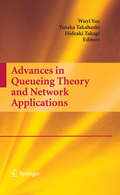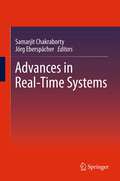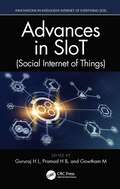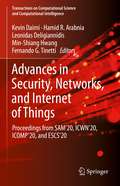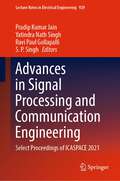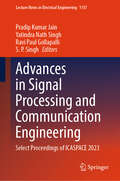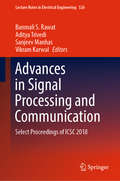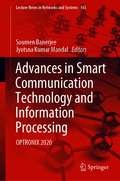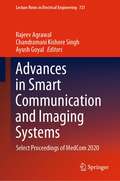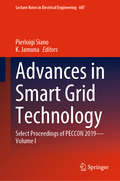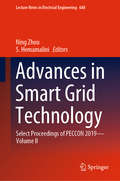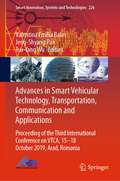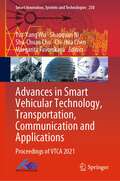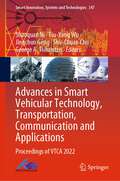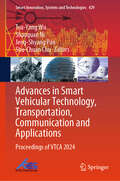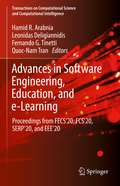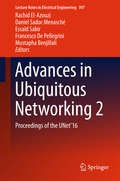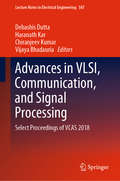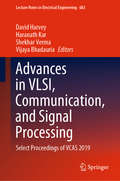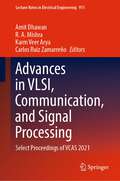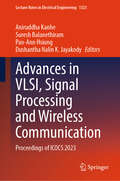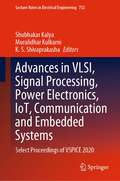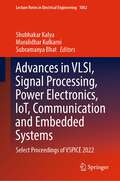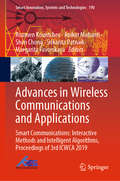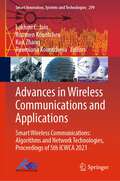- Table View
- List View
Advances in Queueing Theory and Network Applications (Lecture Notes In Mathematics #Vol. 755)
by Yutaka Takahashi Hideaki Takagi Wuyi YueAdvances in Queueing Theory and Network Applications presents several useful mathematical analyses in queueing theory and mathematical models of key technologies in wired and wireless communication networks such as channel access controls, Internet applications, topology construction, energy saving schemes, and transmission scheduling. In sixteen high quality chapters, this work provides novel ideas, new analytical models, and simulation and experimental results by experts in the field of queueing theory and network applications. The text serves as a state-of-the-art reference for a wide range of researchers and engineers engaged in the fields of queueing theory and network applications, and can also serve as supplemental material for advanced courses in operations research, queueing theory, performance analysis, traffic theory, as well as theoretical design and management of communication networks.
Advances in Real-Time Systems
by Jörg Eberspächer Samarjit ChakrabortyThis volume contains the lectures given in honor to Georg Färber as tribute to his contributions in the area of real-time and embedded systems. The chapters of many leading scientists cover a wide range of aspects, like robot or automotive vision systems or medical aspects.
Advances in SIoT (Innovations in Intelligent Internet of Everything (IoE))
by H L Gururaj H B Pramod M GowthamThe Social Internet of Things (SIoT) has become a hot topic in academic research. It employs the theory of social networks into the different levels of the Internet of Things (IoTs) and has brought new possibilities for the development of IoTs. Essentially, the SIoT is a subset of IoTs. It uses intelligent hardware and humans as the node, a social network as the organization type, the social relationship between things, things and humans, and between humans, formatting research methods and models with social network characteristics to realize the connection, service, and application of the IoTs. Moreover, SIoT is a form of realization of technology, architecture, and application of the IoTs using social network research methods. It further promotes the integration between real-world and virtual cyberspace, contributes the realization of the IoTs, expands the research scope of the social networking, and provides a new solution for the specific problems of the IoTs. Consequently, there is a tremendous need for researchers to have a comprehensive knowledge of the advances in SIoT. This special issue is soliciting scientific research papers that can present a snapshot of the latest research status of SIoT.
Advances in Security, Networks, and Internet of Things: Proceedings from SAM'20, ICWN'20, ICOMP'20, and ESCS'20 (Transactions on Computational Science and Computational Intelligence)
by Hamid R. Arabnia Kevin Daimi Leonidas Deligiannidis Min-Shiang Hwang Fernando G. TinettiThe book presents the proceedings of four conferences: The 19th International Conference on Security & Management (SAM'20), The 19th International Conference on Wireless Networks (ICWN'20), The 21st International Conference on Internet Computing & Internet of Things (ICOMP'20), and The 18th International Conference on Embedded Systems, Cyber-physical Systems (ESCS'20). The conferences took place in Las Vegas, NV, USA, July 27-30, 2020. The conferences are part of the larger 2020 World Congress in Computer Science, Computer Engineering, & Applied Computing (CSCE'20), which features 20 major tracks. Authors include academics, researchers, professionals, and students. Presents the proceedings of four conferences as part of the 2020 World Congress in Computer Science, Computer Engineering, & Applied Computing (CSCE'20);Includes the tracks on security & management, wireless networks, internet computing and IoT, and embedded systems as well as cyber-physical systems;Features papers from SAM’20, ICWN’20, ICOMP’20 and ESCS’20.
Advances in Signal Processing and Communication Engineering: Select Proceedings of ICASPACE 2021 (Lecture Notes in Electrical Engineering #929)
by S. P. Singh Pradip Kumar Jain Yatindra Nath Singh Ravi Paul GollapalliThis book comprises select proceedings of the International Conference on Advances in Signal Processing and Communication Engineering (ICASPACE 2021). The book covers several theoretical and mathematical approaches addressing day-to-day challenges in signal, image, and speech processing and advanced communication systems. It primarily focuses on effective mathematical methods, algorithms, and models that enhance the performance of existing systems. The topics covered in the book are advances in signal processing (radar and biomedical), image processing, speech processing, technical and environmental challenges in 5G technology, and strategies for optimal utilization of resources to improve the efficacy of the communication systems in terms of bandwidth and radiating power, etc. The works published in the book will remarkably be helpful to prospective scholars, academicians, and students seeking knowledge in signal processing and communication engineering.
Advances in Signal Processing and Communication Engineering: Select Proceedings of ICASPACE 2023 (Lecture Notes in Electrical Engineering #1157)
by S. P. Singh Pradip Kumar Jain Yatindra Nath Singh Ravi Paul GollapalliThis book comprises select proceedings of the International Conference on Advances in Signal Processing and Communication Engineering (ICASPACE 2023). The book covers several theoretical and mathematical approaches addressing day-to-day challenges in signal, image, and speech processing and advanced communication systems. It primarily focuses on effective mathematical methods, algorithms, and models that enhance the performance of existing systems. The topics covered in the book are advances in signal processing (radar and biomedical), image processing, speech processing, technical and environmental challenges in 5G technology, and strategies for optimal utilization of resources to improve the efficacy of the communication systems in terms of bandwidth and radiating power, etc. The works published in the book will remarkably be helpful to prospective scholars, academicians, and students seeking knowledge in signal processing and communication engineering.
Advances in Signal Processing and Communication: Select Proceedings of ICSC 2018 (Lecture Notes in Electrical Engineering #526)
by Banmali S. Rawat Aditya Trivedi Sanjeev Manhas Vikram KarwalThis book is a collection of selected peer-reviewed papers presented at the International Conference on Signal Processing and Communication (ICSC 2018). It covers current research and developments in the fields of communications, signal processing, VLSI circuits and systems, and embedded systems. The book offers in-depth discussions and analyses of latest problems across different sub-fields of signal processing and communications. The contents of this book will prove to be useful for students, researchers, and professionals working in electronics and electrical engineering, as well as other allied fields.
Advances in Smart Communication Technology and Information Processing: OPTRONIX 2020 (Lecture Notes in Networks and Systems #165)
by Jyotsna Kumar Mandal Soumen BanerjeeThis book is a collection of best selected research papers presented at the 6th International Conference on Opto-Electronics and Applied Optics (OPTRONIX 2020) organized by the University of Engineering & Management, Kolkata, India, in June 2020. The primary focus is to address issues and developments in optoelectronics with particular emphasis on communication technology, IoT and intelligent systems, information processing and its different kinds. The theme of the book is in alignment with the theme of the conference “Advances in Smart Communication Technology and Information Processing.” The purpose of this book is to inform the scientists and researchers of this field in India and abroad about the latest developments in the relevant field and to raise awareness among the academic fraternity to get them involved in different activities in the years ahead – an effort to realize knowledge-based society.
Advances in Smart Communication and Imaging Systems: Select Proceedings of MedCom 2020 (Lecture Notes in Electrical Engineering #721)
by Rajeev Agrawal Chandramani Kishore Singh Ayush GoyalThis book presents select and peer-reviewed proceedings of the International Conference on Smart Communication and Imaging Systems (MedCom 2020). The contents explore the recent technological advances in the field of next generation communication systems and latest techniques for image processing, analysis and their related applications. The topics include design and development of smart, secure and reliable future communication networks; satellite, radar and microwave techniques for intelligent communication. The book also covers methods and applications of GIS and remote sensing; medical image analysis and its applications in smart health. This book can be useful for students, researchers and professionals working in the field of communication systems and image processing.
Advances in Smart Grid Technology: Select Proceedings of PECCON 2019—Volume I (Lecture Notes in Electrical Engineering #687)
by Pierluigi Siano K. JamunaThis book comprises the select proceedings of the International Conference on Power Engineering Computing and Control (PECCON) 2019. This volume focuses on the different renewable energy sources which are integrated in a smart grid and their operation both in the grid connected mode and islanded mode. The contents highlight the role of power converters in the smart grid environment, battery management, electric vehicular technology and electric charging station as a load for the power network. This book can be useful for beginners, researchers as well as professionals interested in the area of smart grid technology.
Advances in Smart Grid Technology: Select Proceedings of PECCON 2019—Volume II (Lecture Notes in Electrical Engineering #688)
by Ning Zhou S. HemamaliniThis book comprises the select proceedings of the International Conference on Power Engineering Computing and Control (PECCON) 2019. This volume covers several important topics such as optimal data selection and error-free data acquiring via artificial intelligence and machine learning techniques, information and communication technologies for monitoring and control of smart grid components, and data security in smart grid network. In addition, it also focuses on economics of renewable electricity generation, policies for distributed generation, smart eco-structures and systems. This book can be useful for beginners, researchers as well as professionals interested in the area of smart grid technology.
Advances in Smart Vehicular Technology, Transportation, Communication and Applications: Proceeding of the Third International Conference on VTCA, 15–18 October 2019, Arad, Romania (Smart Innovation, Systems and Technologies #226)
by Jeng-Shyang Pan Valentina Emilia Balas Tsu-Yang WuThis book constitutes the Proceedings of The Third International Conference on Smart Vehicular Technology, Transportation, Communication and Applications (VTCA 2019), Arad, Romania, held on October 15–18 October 2019 in Arad, Romania. This edition is technically co-sponsored by “Aurel Vlaicu” University of Arad, Romania, Southwest Jiaotong University, Fujian University of Technology, Chang’an University, Shandong University of Science and Technology, Fujian Provincial Key Lab of Big Data Mining and Applications, and National Demonstration Center for Experimental Electronic Information and Electrical Technology Education (Fujian University of Technology), China, Romanian Academy and General Association of Engineers in Romania - Arad Section. The book covers a range of topics including algorithms for optimization, video processing, parking management, IoT, software testing, cryptanalysis, NLP, CNN, wireless sensors network, adaptive security, data protection, green transportation, AI, smart cities, train control, analytic hierarchy process, big data, car following model, etc. The books help to disseminate the knowledge about some active research directions in the field Vehicle Technology and Communication. The book provides useful information to professors, researchers and graduated students in area of Vehicle Technology and Communication.
Advances in Smart Vehicular Technology, Transportation, Communication and Applications: Proceedings of VTCA 2021 (Smart Innovation, Systems and Technologies #250)
by Shu-Chuan Chu Margarita Favorskaya Tsu-Yang Wu Shaoquan Ni Chi-Hua ChenThis book includes selected papers from the fourth International Conference on Smart Vehicular Technology, Transportation, Communication and Applications (VTCA 2021), held in Chengdu City, Sichuan Province, China, during May 22–24, 2021. The conference is technically co-sponsored by Southwest Jiaotong University, Shandong University of Science and Technology, Fujian University of Technology, and Minjiang University. The book includes research works from engineers, researchers, and practitioners interested in the advances and applications in the field of vehicle technology and communication. The book covers four tracks, namely (1) vehicular networking security, (2) vehicular electronics, (3) intelligent transportation systems, and (4) smart vehicular communication networks and telematics.
Advances in Smart Vehicular Technology, Transportation, Communication and Applications: Proceedings of VTCA 2022 (Smart Innovation, Systems and Technologies #347)
by George A. Tsihrintzis Shu-Chuan Chu Tsu-Yang Wu Shaoquan Ni Jingchun GengThis book includes selected papers from the fifth International Conference on Smart Vehicular Technology, Transportation, Communication and Applications (VTCA 2022), held in online mode during December 24–26, 2022. The book includes research works from engineers, researchers, and practitioners interested in the advances and applications in the field of vehicle technology and communication. The book covers four tracks, namely (1) vehicular networking security, (2) vehicular electronics, (3) intelligent transportation systems and applications, and (4) smart vehicular communication networks and telematics.
Advances in Smart Vehicular Technology, Transportation, Communication and Applications: Proceedings of VTCA 2024 (Smart Innovation, Systems and Technologies #429)
by Jeng-Shyang Pan Shu-Chuan Chu Tsu-Yang Wu Shaoquan NiThis book includes selected papers from the sixth International Conference on Smart Vehicular Technology, Transportation, Communication, and Applications (VTCA 2024), hosted by Shu-Te University and Taiwan Association for Web Intelligence Consortium, and is technically sponsored by National Kaohsiung University of Science and Technology and Nanchang Institute of Technology, during April 16–18, 2024. The book includes research works from engineers, researchers, and practitioners interested in the advances and applications in the field of vehicle technology and communication. The book covers three tracks, namely (1) vehicular electronics, (2) intelligent transportation systems and applications, and (3) vehicular networking security.
Advances in Software Engineering, Education, and e-Learning: Proceedings from FECS'20, FCS'20, SERP'20, and EEE'20 (Transactions on Computational Science and Computational Intelligence)
by Hamid R. Arabnia Quoc-Nam Tran Leonidas Deligiannidis Fernando G. TinettiThis book presents the proceedings of four conferences: The 16th International Conference on Frontiers in Education: Computer Science and Computer Engineering + STEM (FECS'20), The 16th International Conference on Foundations of Computer Science (FCS'20), The 18th International Conference on Software Engineering Research and Practice (SERP'20), and The 19th International Conference on e-Learning, e-Business, Enterprise Information Systems, & e-Government (EEE'20). The conferences took place in Las Vegas, NV, USA, July 27-30, 2020 as part of the larger 2020 World Congress in Computer Science, Computer Engineering, & Applied Computing (CSCE'20), which features 20 major tracks. Authors include academics, researchers, professionals, and students. This book contains an open access chapter entitled, "Advances in Software Engineering, Education, and e-Learning".Presents the proceedings of four conferences as part of the 2020 World Congress in Computer Science, Computer Engineering, & Applied Computing (CSCE'20);Includes the tracks Computer Engineering + STEM, Foundations of Computer Science, Software Engineering Research, and e-Learning, e-Business, Enterprise Information Systems, & e-Government;Features papers from FECS'20, FCS'20, SERP'20, EEE'20, including one open access chapter.
Advances in Ubiquitous Networking 2: Proceedings of the UNet’16 (Lecture Notes in Electrical Engineering #397)
by Francesco De Pellegrini Rachid El-Azouzi Essaïd Sabir Mustapha Benjillali Daniel Sadoc MenaschéThis volume offers the proceedings of the 2nd UNet conference, held in Casablanca May 30 - June 1, 2016. It presents new trends and findings in hot topics related to ubiquitous computing/networking, covered in three tracks and three special sessions: Main Track 1: Context-Awareness and Autonomy Paradigms Track Main Track 2: Mobile Edge Networking and Virtualization Track Main Track 3: Enablers, Challenges and Applications Special Session 1: Smart Cities and Urban Informatics for Sustainable Development Special Session 2: Unmanned Aerial Vehicles From Theory to Applications Special Session 3: From Data to Knowledge: Big Data applications and solutions
Advances in VLSI, Communication, and Signal Processing: Select Proceedings of VCAS 2018 (Lecture Notes in Electrical Engineering #587)
by Debashis Dutta Haranath Kar Chiranjeev Kumar Vijaya BhadauriaThis book comprises select proceedings of the International Conference on VLSI, Communication and Signal processing (VCAS 2018). It looks at latest research findings in VLSI design and applications. The book covers a wide range of topics in electronics and communication engineering, especially in the area of microelectronics and VLSI design, communication systems and networks, and image and signal processing. The contents of this book will be useful to researchers and professionals alike.
Advances in VLSI, Communication, and Signal Processing: Select Proceedings of VCAS 2019 (Lecture Notes in Electrical Engineering #683)
by David Harvey Shekhar Verma Haranath Kar Vijaya BhadauriaThis book comprises select peer-reviewed papers from the International Conference on VLSI, Communication and Signal processing (VCAS) 2019, held at Motilal Nehru National Institute of Technology (MNNIT) Allahabad, Prayagraj, India. The contents focus on latest research in different domains of electronics and communication engineering, in particular microelectronics and VLSI design, communication systems and networks, and signal and image processing. The book also discusses the emerging applications of novel tools and techniques in image, video and multimedia signal processing. This book will be useful to students, researchers and professionals working in the electronics and communication domain.
Advances in VLSI, Communication, and Signal Processing: Select Proceedings of VCAS 2021 (Lecture Notes in Electrical Engineering #911)
by Karm Veer Arya Amit Dhawan R. A. Mishra Carlos Ruiz ZamarreñoThis book comprises select peer-reviewed proceedings of the International Conference on VLSI, Communication and Signal processing (VCAS 2021). The contents focus on the latest research in different domains of electronics and communication engineering, in particular microelectronics and VLSI design, communication systems and networks, and signal and image processing. The book discusses the emerging applications of novel tools and techniques in image, video, and multimedia signal processing. This book will be useful to students, researchers, and professionals working in electronics and communication.
Advances in VLSI, Signal Processing and Wireless Communication: Proceedings of ICOCS 2023 (Lecture Notes in Electrical Engineering #1323)
by Dushantha Nalin K. Jayakody Pao-Ann Hsiung Aniruddha Kanhe Suresh BalanethiramThis book presents select proceedings of the International Conference on Communication Systems (ICOCS-2023). The book includes cutting-edge research papers in the emerging fields of communication, signal processing, and VLSI. The book is a unique collection of chapters from different areas with a common theme. It benefits academic researchers and practitioners in the industry who work in this field.
Advances in VLSI, Signal Processing, Power Electronics, IoT, Communication and Embedded Systems: Select Proceedings of VSPICE 2020 (Lecture Notes in Electrical Engineering #752)
by Shubhakar Kalya Muralidhar Kulkarni K. S. ShivaprakashaThis book comprises select peer-reviewed papers from the International Conference on VLSI, Signal Processing, Power Electronics, IoT, Communication and Embedded Systems (VSPICE-2020). The book provides insights into various aspects of the emerging fields in the areas Electronics and Communication Engineering as a holistic approach. The various topics covered in this book include VLSI, embedded systems, signal processing, communication, power electronics and internet of things. This book mainly focuses on the most recent innovations, trends, concerns and practical challenges and their solutions. This book will be useful for academicians, professionals and researchers in the area of electronics and communications and electrical engineering.
Advances in VLSI, Signal Processing, Power Electronics, IoT, Communication and Embedded Systems: Select Proceedings of VSPICE 2022 (Lecture Notes in Electrical Engineering #1062)
by Shubhakar Kalya Muralidhar Kulkarni Subramanya BhatThis book comprises select peer-reviewed papers from the International Conference on VLSI, Signal Processing, Power Electronics, IoT, Communication, and Embedded Systems (VSPICE-2022). The book provides insights into various aspects of electronics and communication engineering as a holistic approach. The various topics covered in this book include VLSI, embedded systems, signal processing, communication, power electronics, and the Internet of Things. The contents mainly focus on the most recent innovations, trends, concerns, and practical challenges and their solutions. This book is useful for academicians, professionals, and researchers in the area of electronics and communications and electrical engineering.
Advances in Wireless Communications and Applications: Smart Communications: Interactive Methods and Intelligent Algorithms, Proceedings of 3rd ICWCA 2019 (Smart Innovation, Systems and Technologies #190)
by Srikanta Patnaik Margarita Favorskaya Roumen Kountchev Aniket Mahanti Shen ChongThis book features selected papers presented at the 3rd International Conference on Wireless Communications and Applications (ICWCA 2019), held at Hainan University, China. Focusing on applications of the latest smart theories and approaches, and recent advances in the field, it covers topics such as OFDM and multi-carrier techniques; smart antenna and space-time signal processing; MIMO, multi-user MIMO, and massive MIMO; modulation, coding, and diversity techniques; dynamic spectrum access and cognitive radio; interference management and radio resource allocation; equalization techniques; synchronization, estimation, and detection techniques; and wireless multiple access (e.g. CDMA, OFDMA, NOMA, ).
Advances in Wireless Communications and Applications: Smart Wireless Communications: Algorithms and Network Technologies, Proceedings of 5th ICWCA 2021 (Smart Innovation, Systems and Technologies #299)
by Lakhmi C. Jain Roumen Kountchev Kun Zhang Roumiana KountchevaThis book features selected papers presented at the 5th International Conference on Wireless Communications and Applications (ICWCA 2021), held at Hainan University, China. The book will focus on the presentation of the newest trends and achievements in the development of intelligent algorithms and network technologies in smart communications, with application in underwater communications, IoT-based marine surface communications as well as state-of-the-art real-time precise location technologies, Wi-Fi/Bluetooth locationing, array signal processing, and many others.
